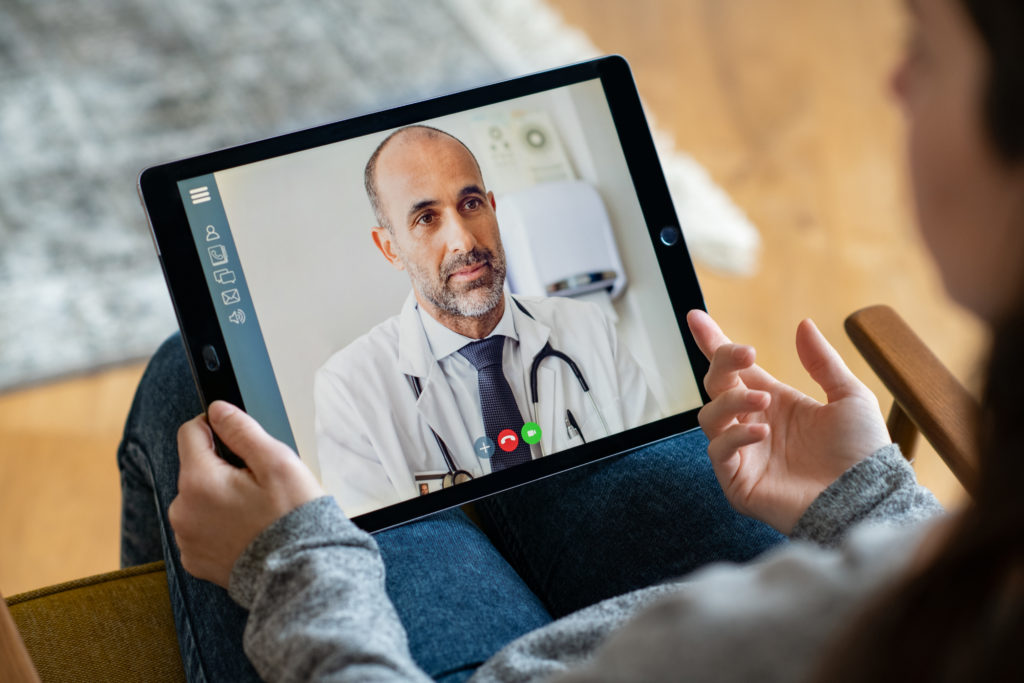The most immediate threat to healthcare in the U.S. is capacity — the capacity of hospitals, emergency departments, and outpatient centers to treat the rising infection rate of COVID-19. In a healthcare system that was already overburdened, healthcare professionals are on the front lines of the outbreak, with incredibly high stress as beds and resources become unavailable. We now face critical shortages of staff, space, and supplies, all factors that can have a negative impact on patient outcomes.
These care and capacity issues are forcing a necessary change in healthcare and the digital ecosystems they operate within, and immediate responses are needed. This pandemic has created a shift: Technology will be the driving factor to change how people engage with healthcare providers. While widespread virtual doctor visits and videoconferencing with mental health providers were formerly seen as the future, COVID-19 has accelerated the behavioral change to make these accepted everyday activities. In the future, patients will demand these technologies, including self-service at-home diagnosis solutions, while leveraging an increased use of connected care and wellness devices. There’s no better time than now to understand that what’s good for people is good for business. Healthcare providers (HCPs) must invest now to ensure they are prepared to meet not just the next crisis, but a new normal.
So how should healthcare organizations (HCOs) navigate our new reality? Here are three ways to rise to the moment:
1. Develop a deeper understanding of patients through human truths
More than ever before, the healthcare industry must develop a deeper understanding of their patients in order to drive effective behavior change, enhance preventive care, and reduce the burden on healthcare organizations. To do this, there are three actions to take now:
- Utilize robust customer 360-degree view capabilities that deliver insight — not just data. Healthcare organizations must have a way of aggregating disparate data sources to get a holistic patient view while combining historical trends and predictive analytics to uncover future potential risks to both the patient and the organization. To do this well, customer relationship managers (CRMs) must provide access to real-time data and insights that enable HCO employees to act, not analyze.
- Employ deep individualization that moves beyond standard customer segmentation. While personalization relies on customer personas, healthcare customers demand, and now require, an experience that resonates with them as individuals. Patients look and act differently from their neighbors — geographic ZIP-code-level insights alone will not deliver accurate recommendations to improve both the patient experience and outcome. HCOs must be able to not only capture the demographic insights, but also understand the emotional and cultural behaviors of their customers. Consumer brands have been doing this for years, and the technologies to enable this are mature and readily available.
- Invest in marketing infrastructure to acquire new customers. Healthcare organizations need to expand their view of patients to start treating them like customers. Customers must navigate a complex ecosystem of players throughout their journey. A highly relevant engagement approach versus traditional methods will retain and keep new customers through long-term care and wellness moments.

2. Accelerate technology to create connection
Innovations will reduce the immediate capacity issues facing healthcare organizations, while also creating a foundation for improving future patient care in a post-COVID world. Here’s how:
- Empower patients to self-serve. Patients are going to insist on greater transparency and access to their health records. When patients have a thorough understanding of diagnoses, treatments, and the implications, they are more likely to adhere to treatment plans. Patient portals provide an easy way for patients to schedule appointments, view test results, pay bills, and communicate with doctors. Making healthcare information easily accessible is a critical part of keeping patients involved and informed in their care. One Medical’s member experience is a hybrid care model and strong example of placing self-serve power in the hands of patients.
- Increase virtual care. Providers have already seen a surge in virtual visits due to the ability to serve vulnerable patients in their homes, mitigate strain on healthcare resources, and calm the anxieties of citizens quarantined in their homes, all while protecting patients, clinicians, and the community from exposure. Jefferson Health has reported a sevenfold increase in traffic to JeffConnect, their telehealth portal program for COVID-19. The portal’s primary function right now is to conduct initial diagnosis in order to limit the number of patients sitting in waiting rooms and doctor’s offices. They have been successful in evaluating and treating patients without in-person contact. While the current landscape lifts many restrictions preventing the widespread rollout of virtual care, the challenge will be centered around supply, not demand.
“With the new Emergency Federal mandates for telehealth, reimbursement will stay as part of the new paradigm in digital health. Also Radiology has seen the highest use of telemedicine between patient and healthcare provider than any other medical specialty according to the American Medical Association. Other specialties can learn from these early adapters who have removed the physical barriers and provided care in real-time especially when it’s needed most.”
— Tim Kelley, CEO, Nautilus Medical Technologies
- Leverage AI to help clinicians focus on more complex cases. Artificially intelligent digital platforms for self-diagnosis are widely available, but the recent COVID-19 environment has made them that much more critical. AI can proactively identify patients who are at risk for disease progression while supporting patient self-triage and recommending service locations. For the past few years, companies like IBM Watson, Google, and Microsoft have been working on advanced algorithms for self-diagnosis and co-diagnosis, poised for accelerated usage and a necessary behavior change. AI can also be utilized in the form of clinician-trained chatbots that can engage and gather information from the patient, ask relevant questions, automatically create notes for patients’ electronic health records, and surface potential diagnoses for clinicians to review. The CDC and Microsoft have developed an AI-powered coronavirus “self-checker” chatbot that helps people who feel sick figure out whether they should go to the hospital.
- Apply voice assistants in the patients/physicians experience. Smart speakers support multiple use cases, such as first aid support, appointment scheduling, and voice-based diagnosis analyzing changes in voice to detect illness or emotional state. Voice technology is no longer a foreign being. Nielsen reports that nearly 25 percent of U.S. households own a smart speaker. Leveraging voice further will reduce the administrative burden on healthcare organizations while allowing patients to self-serve, aiding in self-isolation and delivering a more positive patient experience.
- Develop microservices for promoting and delivering preventive care. Proactive nudges in the form of content, questions, or services will revolutionize the ability to deliver preventive care. Using mobile technology allows patients to collect data, develop insights, and act accordingly to support better decisions and behavior. Apple Watch can already nudge us to stand or to breathe to lower our heart rate. Moving away from monolithic applications to smaller self-contained microservices empowers users in multiple ways ranging from complying with isolation guidelines to avoiding poor air quality, allergens, and more. However, most healthcare organizations are far from prepared to deal with the advent of microservices and IoT. This will require innovation and infrastructure investment.
3. Enhance public outreach and education when needed most
As public health officials focus on strategies to drive patient access to care, it becomes apparent that strategies may not be enough for certain vulnerable or marginalized patient populations. Consider implementing:
- Alternative outreach channels. Immigrants and those who do not speak English as a primary language may miss out on important prevention, screening, and other public health information. These populations typically struggle to engage with the healthcare industry, but this is even more pronounced during a time of emergency. Virtual press conferences livestreamed through Facebook and Instagram provide an alternative channel for non-English content. A virtual press conference, livestreamed through Facebook and Instagram, was hosted by VietRISE and featured a local physician and community advocate who listed a slew of key facts about the virus and instructions on how to stay healthy in Vietnamese and Spanish. HCOs need to consider this type of infrastructure to ensure that non-native English speakers don’t have barriers to care.
- Provide clarity through customer service: Aim to ensure patients know what is going on with the coronavirus, best practices to stem the spread, and how to access care when they need it. These can be delivered through FAQs and increased customer service tactics. CVS has created a COVID-19 Resource Center to better manage their customers’ health and wellness during this time.
Bottom Line
Healthcare organizations that are investing in their patients through technology and meaningful customer experiences will prevail now, and post-COVID-19, ensuring that all audiences receive the attention and care they need. Digital transformation is no longer a luxury but a necessity for healthcare in a post-crisis world. Hero is working with those in the healthcare industry with the same mindset to unlock CX value in first-party data and technology, and achieve ROI to create customer and business value.
Interested in speaking to our healthcare industry experts who can share ideas and accelerate your digital transformation? Contact us.







